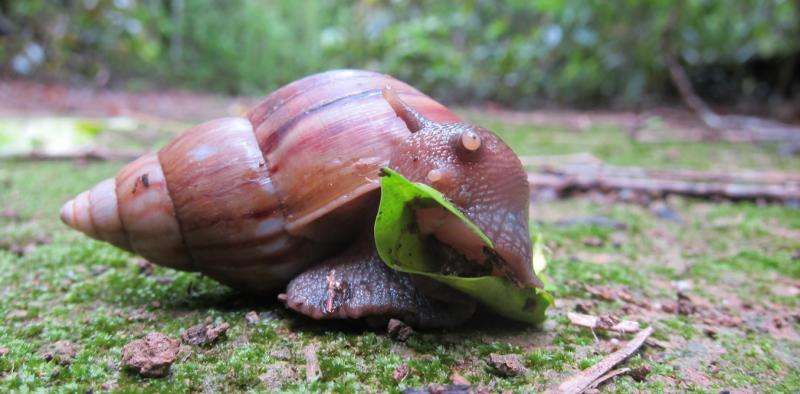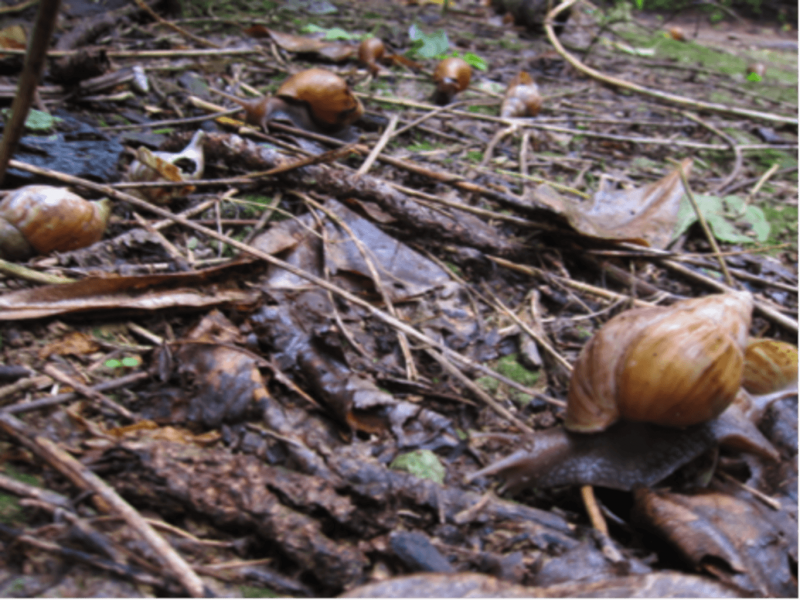Who's afraid of the giant African land snail? Perhaps we shouldn't be

The is a poster child of a global epidemic: the threat of invasive species. The snails are native to coastal East Africa, but are now found across Asia, the Pacific and the Americas – in fact, almost all tropical mainlands and islands except mainland Australia.
Yet, despite their fearsome reputation, on Christmas Island's invasive snail population suggests the risk they pose to native ecosystems has been greatly exaggerated.
Giant African land snails certainly have the classic characteristics of a successful invader: they can thrive in lots of different places; survive on a broad diet; reach reproductive age quickly; and produce more than 1,000 eggs in a lifetime. Add it all together and you have a species recognised as .
The snails can eat , including vegetable crops (and even calcium-rich ), and have been described as a to agriculture.
They have been , and the Department of Primary Industries concurs that the snails are a "".
Despite all this, there have been . Some suggest the risk to agriculture has been exaggerated from accounts of damage in gardens. There are no accounts of giant African land snails destroying natural ecosystems.
Quietly eating leaf litter
In research recently published in the journal , we tested these assumptions by investigating giant African land snails living in native rainforest on Christmas Island.
Giant African land snails have spread through Christmas Island with the help of another invasive species: the .
Until these ants showed up, abundant native ate the giant snails before they could gain a foothold in the rainforest. Unfortunately, yellow crazy ants have completely exterminated the crabs in some parts of the island, allowing the snails to flourish.

We predicted that the snails, which eat a broad range of food, would have a significant impact on leaf litter and seedling survival.
However, our evidence didn't support this at all. Using several different approaches – including a field experiment, lab experiment and observational study – we found giant African land snails were pretty much just eating a few dead leaves and little else.
We almost couldn't distinguish between leaf litter removal by the snails compared to natural decomposition. They were eating leaf litter, but not a lot of it.
We saw almost no impact on seedling survival, and the snails were almost never seen eating live foliage. In one lab trial, we attempted to feed snails an exclusive diet of fresh leaves, but so many of these snails died that we had to cut the experiment short. Perhaps common Christmas Island plants just aren't palatable.
It's possible that the giant African land snails are causing other problems on Christmas Island. In Florida, for example, they . But for the key ecological processes we investigated, the snails do not create the kind of disturbance we would assume from their large numbers.
The assumption that giant African land snails are dangerous to native plants and agriculture comes from an overriding sentiment that invasive species are damaging and must be controlled.
Do we have good data on the ecological impact of all invasive species? Of course not. Should we still try to control all abundant invasive species even if we don't have evidence they are causing harm? That's a more difficult question.
The drives much of the thinking behind the management of invasive species, including the giant African land snail. The cost of doing nothing is potentially very high, so it's safest to assume invasive species are having an effect (especially when they exist in high numbers).
But we should also be working hard to test these assumptions. Proper monitoring and experiments give us a true picture of the risks of action (or inaction).
In reality, the giant African land snail is more the poster child of our own knee-jerk reaction to abundant invaders.
Provided by The Conversation
This article was originally published on . Read the .![]()
















